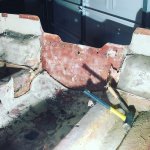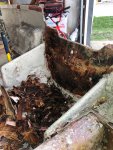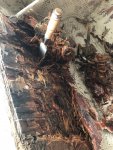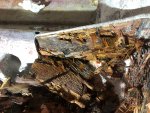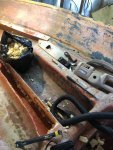Hello all! Working on restoring my 95' Glastron. This boat was filled/sunk by the previous owner. Left the plug in over a summer he wasn't home and filled it with water. Last season i ripped out the interior and the deck. This spring i pulled bow deck off. Next i was able to see the transom. Once I split the rub rail and lifted the upper hull cover i was able to see the top of the wood. Initially it didn't look too bad... but after taking a deeper look. Its rot. And pretty bad at that. See steps below
Progress
-----------
-Glass covering transom cut out
-Wood transom removed completely
Questions
--------------
-Whats the best way to prep the transom in this state? Do i glass the two pieces of wood together? Screw them together? Do i just epoxy them together?
-Will i encase the transom in chopped glass before mounting it to the boats glass or maybe just epoxy?
-My resin of choice was vinyl ester.
Plan if i don't get any input
--------------
-finish prepping the glass on the boat (sanding ridges flush)
-cut the transom from 3/4" meranti bs1088 (local supplier)
-sandwich the wood together with vinylester... staple or screw it together
-make a resin, chopped glass, silicate "peanut butter"
-liberally apply peanut butter all over mounting face of wood and boat mounting surface
-clamp into position
-let cure?
-Peanut butter fill a nice fillet around transom to boat
-chopped mat strips filleting over the peanut butter to boat from wood
-cover transom in chopped mat 1-2 layers
-cover chopped mat with woven. swarf this in about 12" on both sides of the transom and below.
Input appreciated- flying by the seat of my pants
Progress
-----------
-Glass covering transom cut out
-Wood transom removed completely
Questions
--------------
-Whats the best way to prep the transom in this state? Do i glass the two pieces of wood together? Screw them together? Do i just epoxy them together?
-Will i encase the transom in chopped glass before mounting it to the boats glass or maybe just epoxy?
-My resin of choice was vinyl ester.
Plan if i don't get any input
--------------
-finish prepping the glass on the boat (sanding ridges flush)
-cut the transom from 3/4" meranti bs1088 (local supplier)
-sandwich the wood together with vinylester... staple or screw it together
-make a resin, chopped glass, silicate "peanut butter"
-liberally apply peanut butter all over mounting face of wood and boat mounting surface
-clamp into position
-let cure?
-Peanut butter fill a nice fillet around transom to boat
-chopped mat strips filleting over the peanut butter to boat from wood
-cover transom in chopped mat 1-2 layers
-cover chopped mat with woven. swarf this in about 12" on both sides of the transom and below.
Input appreciated- flying by the seat of my pants




















